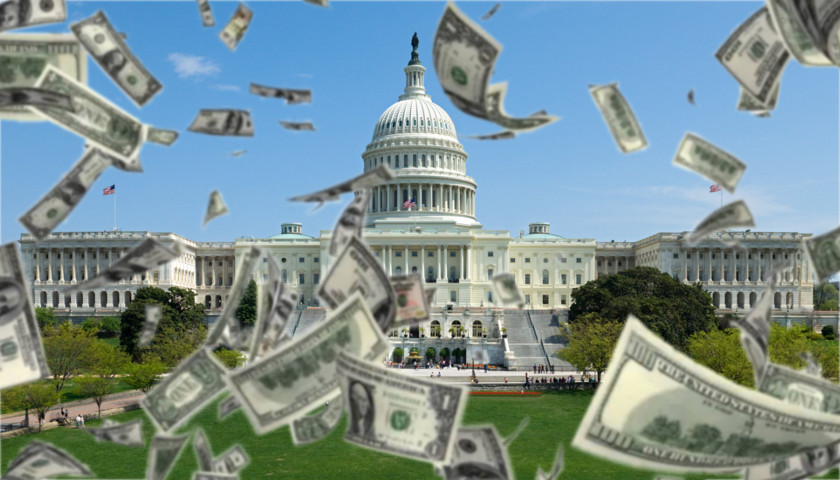by Edward Ring
“I am not worried about the deficit,” Ronald Reagan famously said. “It is big enough to take care of itself.”
If you pay attention to the libertarian purists, President Reagan earns mixed reviews on his economic policies. After all, in 1983, the federal budget deficit exceeded 6 percent of GDP. But Reagan was untroubled by federal budget deficits for at least two reasons, and in both cases he has been vindicated by history.
Reagan’s priorities were to unleash the American economy, which he accomplished through deregulation, and to invest in American military supremacy. As the federal budget surpluses of the 1990s and the collapse of the Soviet Union can attest, Reagan had his priorities straight, and got the results he sought.
When it comes to deficit spending and the military challenges facing an American president, Reagan and Trump have a lot in common. Mostly through executive orders, and to some extent through legislation, Trump has deregulated the American economy. He has also successfully reinvested in America’s military.
 To put this in perspective, Trump’s projected 2019 federal budget deficit of $960 billion is 4.5 percent the 2019 GDP projection of $21.2 trillion. And Trump’s projected 2019 defense budget of $716 billion is 3.3 percent of GDP. Military spending during most of the Reagan years was around 6 percent of GDP, and during his presidency the federal budget deficits averaged 4.3 percent.
To put this in perspective, Trump’s projected 2019 federal budget deficit of $960 billion is 4.5 percent the 2019 GDP projection of $21.2 trillion. And Trump’s projected 2019 defense budget of $716 billion is 3.3 percent of GDP. Military spending during most of the Reagan years was around 6 percent of GDP, and during his presidency the federal budget deficits averaged 4.3 percent.
Like Reagan, Trump took office having to clean up after a predecessor whose foreign policy amounted to feckless weakness and futile moralizing. Jimmy Carter faced Soviet aggression, Barack Obama faced Communist China. Neither of them were taken seriously by these adversaries. Both of them neglected America’s military. But Trump’s mess is bigger than Reagan’s ever was.
Bold Investment Will Be Vital to Counter China
To properly deter China, an expansionist, racist, fascist kleptocracy bent on world domination, a high-tech prison camp with 1.3 billion inmates, America’s defense budget should rise to the percentage of GDP that it was during the Reagan years. This would suggest that America’s defense budget for 2019 should rise to 6 percent of projected GDP, or increase by over a half-trillion dollars from $716 billion to $1.3 trillion. Although this increased spending would generate some offsetting new tax receipts, in 2019 it hypothetically could increase the federal budget deficit from the currently projected 4.5 percent of GDP to as much as 7.1 percent of GDP.
Without something approaching that level of new investment, the United States will struggle to maintain and upgrade its existing military assets and, at the same time, conduct fast-tracked investment in next-generation strategic weapons.
In an era where irony abounds, it’s particularly ironic that among Trump’s greatest critics are also those who are seizing upon the trendy new “modern monetary theory” (MMT) to claim that deficits don’t matter. An only slightly oversimplified summary of MMT would be the following: as long as the government has a monopoly on the issuance of currency, then the government can print as much money as it needs, and therefore deficits don’t matter. Just print more money.
There are plenty of lucid criticisms of MMT, but in one vitally important context, some critics miss the point. If resorting to MMT truly is unsustainable in the long-run, then what all that money is used for in the short run matters a great deal.
According to economic sages on the left, such as Alexandria Ocasio-Cortez, the federal government needs to print money—heedless of deficits—in order to pay for free college tuition, free healthcare, and a host of other wonderful benefits. But while the American Left wins elections by promising more benefits, this is not the best use of funds.
To the extent military spending goes into the pockets of soldiers who spend the money in America, or they send it home to be spent by their families in America, it has the same Keynesian benefit as more broadly distributed benefits such as free tuition or free healthcare for everyone. But reforming healthcare policy and dismantling most of the education bureaucracy are necessary prerequisites that might actually make increased government spending unnecessary in those areas.
Military spending, on the other hand, has the salutary benefit of making America able to deter China. Spending on research and development for new strategic weaponry also delivers the Keynesian boost, while guaranteeing America’s military remains the most fearsome on earth, and yielding technological spin-offs that benefit America’s private technology sector.
The other place where deficit spending would yield strategic economic benefits is in infrastructure.
Back in the 1930s, after the last debt bubble collapsed and America encountered a liquidity crisis, deficit spending put millions of Americans to work. Unlike the fraudulent “shovel-ready” infrastructure scam perpetrated a few years ago by Obama and his banker cronies, during the 1930s the Americans built hydroelectric dams across the United States. They rolled out rural electrification projects. They upgraded America’s infrastructure to make the nation competitive in the 20th century. The infrastructure investments made in the 1930s are still paying dividends to the American people.
To be fair to President Obama, he did not create the paralyzing, extortionate shakedown that constitutes infrastructure approvals in 21st century America. These days, funding an infrastructure project feeds most of the money into the pockets of attorneys, environmental consultants, and government bureaucrats. Applications take years, and almost nothing ever gets built. For several decades, Americans have been living with an aging infrastructure that was actually built 50 to 100 years ago.
Where the Economy Is Headed Is Bigger Than Any President
To be fair to President Trump, if the economy falls off a cliff, it will be the result of a debt binge joy ride that began in the 1980s. Unlike Reagan, who started his presidency confronting negligible national debt, Trump faces an accumulated federal debt burden nearly equal to GDP. But in a nod to the MMT gang, it is unlikely that more deficit spending will push the U.S. economy off a cliff, because for that to occur, international confidence in the U.S. dollar would have to falter. And how could that possibly occur?
America is the only major economy on earth that has it all —a preeminent military, preeminent technology, the best universities, political stability, human rights, demographic health, abundant natural resources, and diverse industries. As for America’s debt burden, it is less problematic than the many financial challenges facing the European Union and the Chinese, which are the only other economies big enough for their currencies to challenge the United States.
This is why President Trump is right to urge the Federal Reserve to cut interest rates. It helps people living in the United States to devalue the U.S. currency, and it is in the interests of the United States to experience high single-digit inflation across all industries for many years. Devaluing the U.S. currency would force manufacturers to source raw materials and skilled labor domestically, creating more jobs and wealth. Moderate inflation will whittle away the real value of American consumer debt, as well as the real value of the debt burden that confronts American government agencies at all levels.
For all of this to work, however, fundamental changes are necessary in two areas of national policy.
First, immigration will have to be further controlled, in order to turn the job market into a sellers market, bidding up wages at a faster rate than inflation. Second, extreme environmental laws and regulations will have to be repealed, in order to allow U.S. companies to tap America’s rich store of natural resources to replace foreign sources. Without these changes, currency devaluation could be a perilous gamble.
Economists who object to lowering interest rates fear that in an economic downturn, if interest rates are already too low, it will be impossible to rely on lowering them further in order to stimulate the economy. They’re right, but America’s economic prospects versus the rest of the world evoke the parable of the two men fleeing an aggressive bear in the woods. The survivor does not have to run faster than the bear, he only has to run faster than the other human. There is no nation on earth that is positioned even slightly as well as the United States to survive a global downturn.
There are contingency plans to inject liquidity in the markets in the event of a severe downturn. To ensure it is not a fool’s errand, however, a temporary fix, the United States has to use deficit spending to make investments that bring it into the 21st century—resilient new infrastructure, and military technology that leapfrogs that of our adversaries.
– – –
Edward Ring is a senior fellow of the Center for American Greatness. He is a co-founder of the California Policy Center, a free-market think tank.




